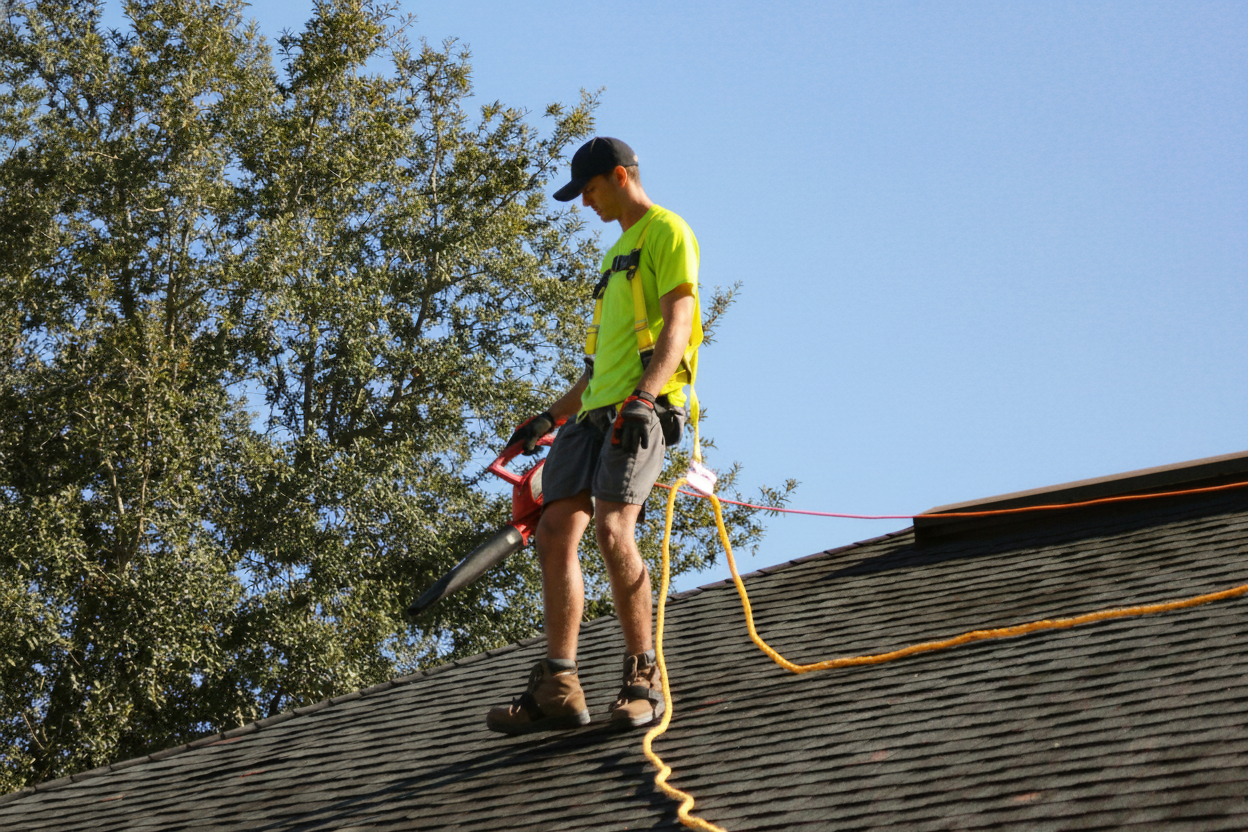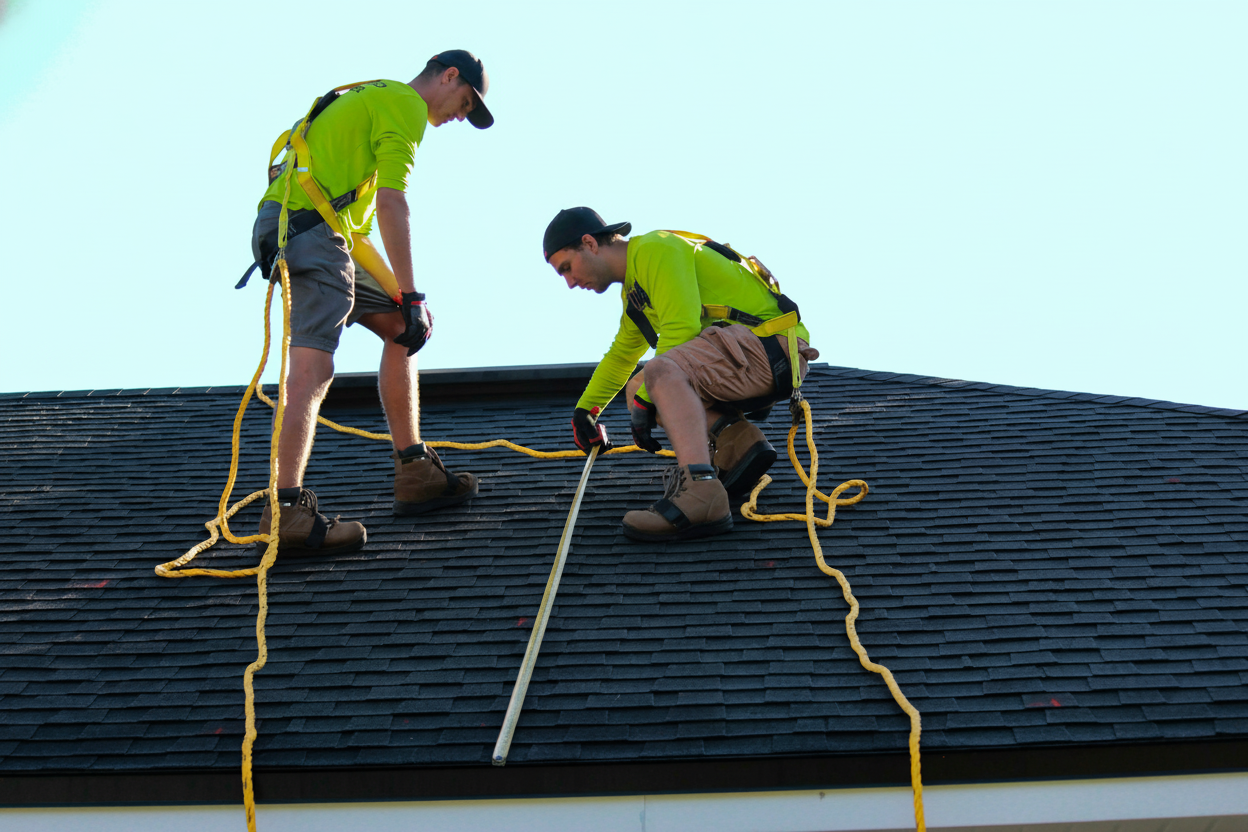How To Remove Mold And Algae From Florida Roofs In 2025
Florida-Specific Roofing & Climate Challenges
November 22,2025
How to remove mold and algae from Florida roofs in 2025

Alt text: Professional roofing technicians safely cleaning mold and algae from a residential Florida roof, showing proper safety equipment and cleaning techniques
Florida’s humid climate creates perfect conditions for mold and algae growth on roofs. Dark streaks and green patches are not just cosmetic issues. They can reduce your roof’s lifespan, increase energy costs, and lead to expensive structural repairs if left untreated.
Understanding how moisture, heat, and poor drainage combine in Florida’s environment helps you protect your investment and maintain your home’s value.
At Foxhaven, we help Florida homeowners prevent and remove roof mold and algae safely. This guide shows you proven strategies to clean your roof, prevent future growth, and avoid costly damage.
Why Florida roofs develop mold and algae faster
Florida’s tropical climate combines high humidity, frequent rainfall, and intense heat. These conditions create an ideal environment for mold and algae to thrive on roof surfaces. Porous materials like clay tiles, concrete, and asphalt shingles are particularly vulnerable to organic growth.
Shaded areas on your roof trap moisture longer. Poor drainage systems and clogged gutters make the problem worse. Even modern roofing materials designed for Florida homes can develop mold without proper maintenance.
Common problem areas on Florida roofs
Moisture accumulates in specific locations due to design features and environmental factors:
- North-facing roof sections that receive less direct sunlight
- Areas under overhanging tree branches that create constant shade
- Valleys and low points where water pools after rain
- Damaged or missing roof components that allow water penetration
- Improperly installed flashing around chimneys and vents
Regular inspections help identify problem areas before mold and algae cause structural damage or require complete roof replacement.
Prevention strategies that work in Florida’s climate
Preventing mold and algae is more cost effective than removal and repair. Understanding how high humidity destroys roofs helps you take proactive steps to protect your home.
Select algae-resistant roofing materials
When replacing or installing a new roof, choose materials with built-in algae resistance. Many manufacturers now offer shingles with copper or zinc granules that inhibit organic growth. Metal roofing options naturally resist mold and algae better than traditional materials.
Compare your options by reviewing the best roofing materials for Florida heat to find solutions that match your budget and home design.
Install proper ventilation and drainage systems
Adequate attic ventilation reduces moisture buildup under your roof deck. Ridge vents, soffit vents, and proper insulation work together to maintain airflow and prevent condensation.
Ensure your gutters and downspouts direct water away from your foundation. Clean gutters regularly, especially during Florida’s rainy season. Poor drainage creates standing water that accelerates mold growth.
Apply protective roof coatings
Roof coatings create a barrier against moisture penetration and UV damage. These products reflect sunlight, reduce surface temperature, and make it harder for mold and algae to establish colonies on your roof.
Protective coatings extend roof lifespan and improve energy efficiency. They work particularly well on flat roofs and low-slope designs common in Florida commercial buildings.
Safe cleaning methods for removing mold and algae
Cleaning mold and algae requires careful technique to avoid damaging your roof. Aggressive pressure washing can strip protective granules from shingles or crack tiles. Always prioritize safety when working at heights.

Alt text: Homeowner and roofing professional conducting a detailed roof inspection in Florida, examining for mold, algae, and moisture damage
Soft washing vs pressure washing
Soft washing uses low-pressure water combined with specialized cleaning solutions. This method effectively kills mold and algae without damaging roof materials. Professional roofers prefer soft washing for delicate surfaces like clay tiles and aged asphalt shingles.
Pressure washing can be appropriate for concrete tile and metal roofs when used correctly. However, incorrect pressure settings or technique can void warranties and create leaks. Consider hiring professionals familiar with regular roof inspections in Florida to ensure safe cleaning.
Recommended cleaning solutions for Florida roofs
| Solution Type | Best For | Application Method | Typical Cost |
|---|---|---|---|
| Chlorine bleach mix | Heavy algae removal | Spray and rinse | Low |
| Oxygen bleach | Eco-friendly cleaning | Spray and wait | Medium |
| Commercial biocides | Long-term prevention | Professional application | Higher |
| Zinc strips | Ongoing protection | Install at ridge | One-time |
After storms, inspect and clean your roof promptly to prevent mold from establishing in damaged areas.
When to hire professional roof cleaners
Steep roofs, multi-story homes, and extensive mold growth require professional expertise. Licensed contractors have proper safety equipment, insurance coverage, and experience with Florida’s specific roofing challenges.
Professionals can identify underlying issues like damaged flashing or deteriorating underlayment. They understand how coastal air damages roofs and can recommend preventive measures specific to your location.
Maintenance schedule for Florida homeowners
Consistent maintenance prevents small problems from becoming expensive repairs. Florida’s climate demands more frequent attention than other regions.
Schedule professional inspections twice yearly, ideally before and after hurricane season. These inspections should check for storm damage, including reviewing signs of storm damage to your roof that indicate immediate attention.
Clean gutters and downspouts quarterly to maintain proper drainage. Trim overhanging branches to increase sunlight exposure and reduce debris accumulation. Remove leaves and organic matter from roof valleys where moisture collects.
Stay prepared for severe weather by following our Florida hurricane roof preparation guidelines. Understanding wind uplift dangers helps you reinforce vulnerable areas before storms arrive.
